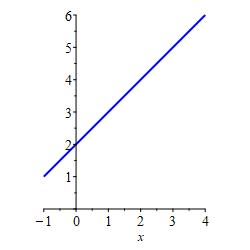6. Intuitive Limits and Continuity
We begin our study of Calculus with Limits. In this chapter we want to develop an intuitive understanding of limits. In a later chapter, we will get a more precise definition.
a. What my Algebra Teacher Never Told me!
We begin with a multiple choice question you might have gotten in a high school algebra class:
Simplify the function \(f(x)=\dfrac{x^2-4}{x-2}\).
\(f(x)=x-2\) \(f(x)=x+2\) Undefined None of these
Incorrect. Sorry that's not correct. Factor the numerator and cancel!
Incorrect. This is the answer you would have given in a high school algebra class,
but it is not correct in a calculus class. If we factor the numerator and
cancel we appear to get
\[
\dfrac{x^2-4}{x-2}=\dfrac{(x+2)(x-2)}{x-2}=x+2
\]
However, we cannot just cancel.
Notice \(f(x)=x+2\) is defined for all \(x\), but,
\(f(x)=\dfrac{x^2-4}{x-2}\) is undefined at \(x=2\) because we
would be dividing by \(0\). If we cancel, we lose the fact that \(f(x)\)
is undefined at \(x=2\).
Incorrect. You are on the right track, but \(f(x)\) is defined for most \(x\).
Correct! \(f(x)=x+2\) is defined for all all \(x\). However, \(f(x)=\dfrac{x^2-4}{x-2}\) is undefined at \(x=2\) because we would be dividing by \(0\). So a correct simplification would be: \[\begin{aligned} f(x)&=\dfrac{x^2-4}{x-2}=\dfrac{(x+2)(x-2)}{x-2} \\ &=\left\{\begin{matrix} x+2 & \text{if} & x\ne2 \\ \text{undefined} & \text{if} & x=2 \end{matrix}\right. \end{aligned}\]
\(\leftarrow\leftarrow\leftarrow\) Be sure to read this after you do the exercise!
So a correct simplification in the above exercise is: \[\begin{aligned} f(x)&=\dfrac{x^2-4}{x-2}=\dfrac{(x+2)(x-2)}{x-2} \\ &=\left\{\begin{matrix} x+2 & \text{if} & x\ne2 \\ \text{undefined} & \text{if} & x=2 \end{matrix}\right. \end{aligned}\] A plot of \(f(x)\) is shown at the right.

The graph of \(y=x+2\) is a straight line with slope \(m=1\) and
\(y\)-intercept \(b=2\) as shown at the right.
The graph of \(y=\dfrac{x^2-4}{x-2}\) is the
same straight line but with a hole at \(x=2\) as shown above.

If we look at the graph, we see that as \(x\) approaches \(x=2\), the value of \(y\) approaches \(y=4\). (This is the value we get if we plug \(x=2\) into \(y=x+2\).) To capture this idea of approaching \(y=4\) even though we can never actually get there, we define the limit: \[ \lim_{x\to2}f(x) =\lim_{x\to2}\dfrac{x^2-4}{x-2} =4 \] This (intuitive) definition will be made clearer on the next page.
Heading
Placeholder text: Lorem ipsum Lorem ipsum Lorem ipsum Lorem ipsum Lorem ipsum Lorem ipsum Lorem ipsum Lorem ipsum Lorem ipsum Lorem ipsum Lorem ipsum Lorem ipsum Lorem ipsum Lorem ipsum Lorem ipsum Lorem ipsum Lorem ipsum Lorem ipsum Lorem ipsum Lorem ipsum Lorem ipsum Lorem ipsum Lorem ipsum Lorem ipsum Lorem ipsum